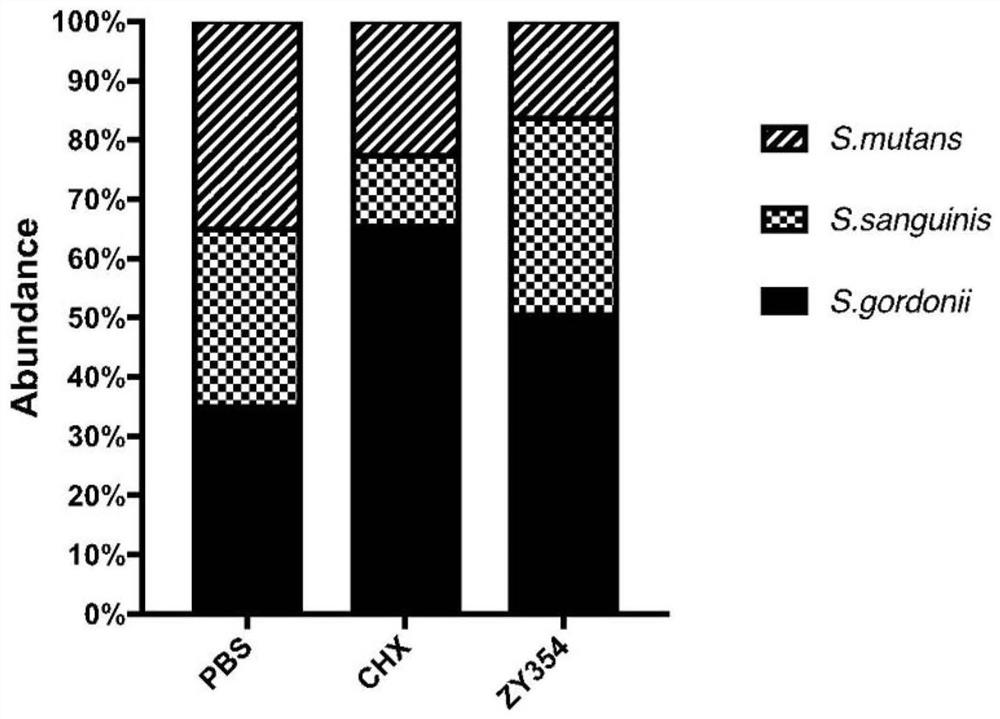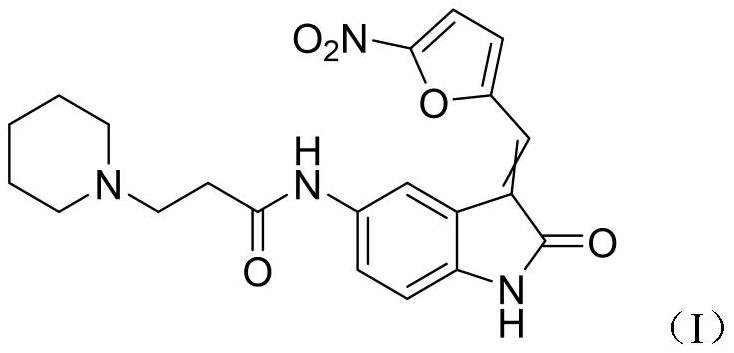Application of indole-2-ketone compound in preparation of product for preventing and treating oral bacteria
A technology of ketone compounds and compounds, which is applied in the field of biomedicine, can solve the problems of high toxicity and difficult removal of deep biofilms in dentinal tubules, and achieve good selective effects
- Summary
- Abstract
- Description
- Claims
- Application Information
AI Technical Summary
Problems solved by technology
Method used
Image
Examples
Embodiment 1
[0024] Embodiment 1. The in vitro antibacterial activity experiment of formula (I) compound
[0025] The preparation of Streptococcus mutans UA159, Streptococcus sanguis ATCC10556, Streptococcus villatum DL1 and Enterococcus faecalis bacterial strain ATCC29212 and formula (I) compound is as follows:
[0026]Streptococcus mutans UA159, Streptococcus sanguis ATCC10556, Streptococcus mutans DL1 and Enterococcus faecalis ATCC29212 strains used in the present invention are all model strains. The reference genome numbers in the NCBI database (www.ncbi.nlm.nih.gov / ) correspond to NC_004350, NC_009009, NC_009785 and NC_004668. Its optimum culture medium is preferably brain heart infusion (BrainHeartInfusion) medium (Braininfusionsolids12.5g / L, Beefheartinfusionsolids5.0g / L, Proteose peptone10.0g / L, Glucose2.0g / L, Sodiumchloride5.0g / L, Di- Sodium phosphate2.5g / L, pH7.4±0.2), static culture at 37°C, the most suitable condition for anaerobic culture.
[0027] The medium for cultivating...
Embodiment 2
[0046] Embodiment 2. The toxicity test of formula (I) compound to human oral cavity cell
[0047] The preparation of human oral keratinocyte HOK, human gingival epithelial cell HGE, human macrophage RAW, human periodontal ligament fibroblast PDLC, human osteosarcoma cell MG63 and formula (I) compound is as follows:
[0048] Human oral epithelial keratinocyte HOK, human gingival epithelial cell HGE, human macrophage RAW, human periodontal ligament fibroblast PDLC, and human osteosarcoma cell MG63 used in the present invention are all cell lines. The culture medium used is DMEM high-glucose medium (containing L-glutamine, 110mg / L sodium pyruvate)+10% fetal bovine serum+1% penicillin and streptomycin mixed solution
[0049] The compound of formula (I) was prepared according to the method described in Example 1.
[0050] The medium for culturing human oral keratinocytes HOK, human gingival epithelial cells HGE, human macrophages RAW, human periodontal ligament fibroblasts PDLC, a...
Embodiment 3
[0058] Embodiment 3. formula (I) compound is to oral cavity bacteria multi-species biofilm removal experiment
[0059] According to the method described in Example 1, Streptococcus mutans, Streptococcus sanguis, Streptococcus sanguinis bacterium liquid and formula (I) compound are prepared, will be in logarithmic phase Streptococcus mutans, Streptococcus sanguis with brain heart infusion-sucrose culture medium , Dilute Streptococcus streptococci to a final concentration of 1×10 5 CFU / mL, mix the three bacterial solutions 1:1:1 for use.
[0060] Add 300 μL of the mixed bacterial solution in (1) to a sterile U-Slide well plate (brand Ibidi, product number 80826), and culture in an anaerobic incubator at 37°C for 24 hours.
[0061] Add brain heart infusion-sucrose medium to prepare the concentration of the formula (I) compound that is 62.5 μ g / mL in each hole, control group adds the chlorhexidine of equal concentration, handles 3 times every day, each processing time is 5 Minut...
PUM
 Login to View More
Login to View More Abstract
Description
Claims
Application Information
 Login to View More
Login to View More - R&D
- Intellectual Property
- Life Sciences
- Materials
- Tech Scout
- Unparalleled Data Quality
- Higher Quality Content
- 60% Fewer Hallucinations
Browse by: Latest US Patents, China's latest patents, Technical Efficacy Thesaurus, Application Domain, Technology Topic, Popular Technical Reports.
© 2025 PatSnap. All rights reserved.Legal|Privacy policy|Modern Slavery Act Transparency Statement|Sitemap|About US| Contact US: help@patsnap.com



